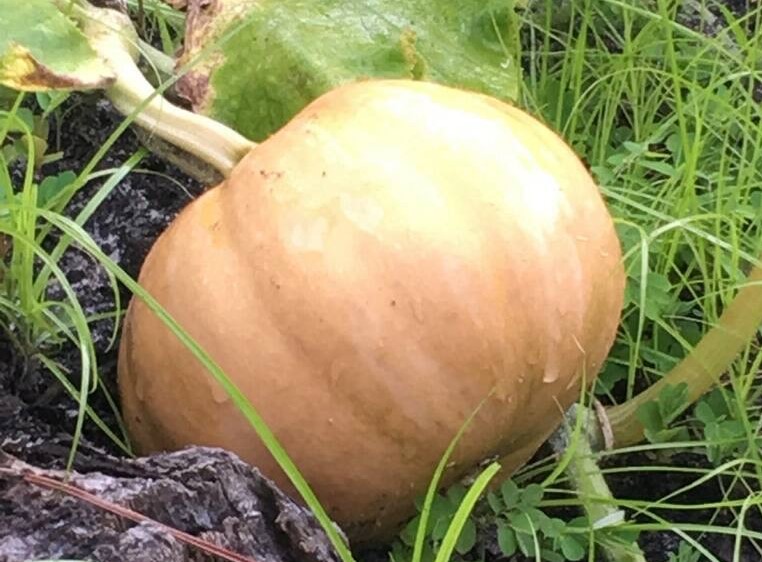
Pumpkins may be associated with all things crisp and cool. But that imagery is hard to hold up in the Sunshine State, no matter how much we surround ourselves in faux foliage. So today, we’re going to introduce you to a heat-loving gourd that has true Florida roots: the Seminole pumpkin. This native squash has learned to thrive in our tropical climate over the hundreds of years of its domestication.
These pumpkins are deeply intertwined in Florida’s history. The Seminole, Calusa, Creek, and Miccosukee people cultivated this pumpkin by planting it at the base of dead trees where the vines could climb up their trunks and the pumpkins would hang. The Seminole word “chassahowitzka” loosely translates to “hanging pumpkin.” A region north of Tampa is named after this cultivation practice. These pumpkins, with their numerous uses, were a staple for locals. When Europeans first settled in Florida, they took note of the pumpkin plants’ large yields and the vertical growing practice that allowed hundreds of acres to be cultivated.

Unlike the relatively uniform pumpkins you find in grocery stores, Seminole pumpkins are as unique as a fingerprint. These pumpkins come in a wide variety of colors and shapes—greens and oranges, round and oblong—and can weigh up to 12 pounds. They have qualities that allow them to thrive in this environment. Their shell-like skin helps them retain water during our dry cooler seasons, and if you look closely at the pumpkin’s leaves, you’ll notice they have white markings which might make them look unhealthy. As it turns out, this is a protective measure. Herbivores, like deer, rabbits, or squirrels, are quite particular about the quality of leaves they will eat, turning up their snouts and sniffers to anything appearing slightly substandard.

You can root yourself in Florida history by growing your own Seminole pumpkin. In South Florida, you can plant them in the spring or fall (those living in Central and North Florida should stick to a springtime planting). You can buy these pumpkins at some local plant nurseries; we suggest calling first to make sure that they have them. You can also order seeds online from a variety of different seed distributors such as ECHO, Southern Exposure Seed Exchange, or Sow True Seed. When you are considering planting them, make sure that you have adequate space because these vines can grow up to 25 feet! You should be able to harvest your first Seminole pumpkin around 60 to 90 days after planting—just in time for fall.
Seminole pumpkins have sweet flesh like butternut squash and can be prepared in similar ways. In addition, the young green fruits can be eaten without peeling. The yellow flowers can be eaten raw, stuffed, or even fried. The pumpkin can be baked, steamed or made into a pie. If you want to try your hand at making a very different kind of pumpkin bread, consider the Seminole variety. This bread is more like an empanada or fritter than the cinnamon-infused loaves we enjoy this time of year. To make traditional Seminole pumpkin bread, check out this recipe.

If cooking is not your strong suit and you prefer pumpkins as décor, the hollowed-out rind can be dried and used for crafting. You can make bowls, cups or even instruments. Just be prepared to wait; it can take a few months to completely dry gourd skins.
Talk about a plant with deep roots. By understanding how traditional cultures used plants allows today’s Floridians to form a more meaningful connection with nature and our region’s heritage. Now you can sow your own roots with the Seminole pumpkin!
 This blog is part of this year’s Roots: Power of the Unseen theme, which celebrates the complex world beneath our feet and seeks to inspire a new appreciation for the unnoticed, yet vital parts of our ecosystem.
This blog is part of this year’s Roots: Power of the Unseen theme, which celebrates the complex world beneath our feet and seeks to inspire a new appreciation for the unnoticed, yet vital parts of our ecosystem.
 About the Author
About the Author
Abigail Swisher is Education Programs Assistant at Naples Botanical Garden. She enjoys and finds inspiration on the various hiking trails throughout the Naples area. Her favorite plants in the Garden are the Victorian waterilies and the silk floss tree.


